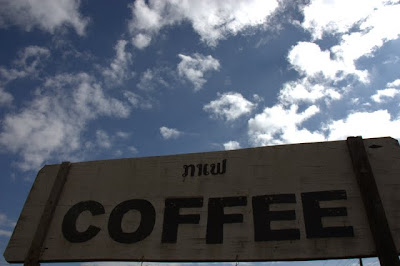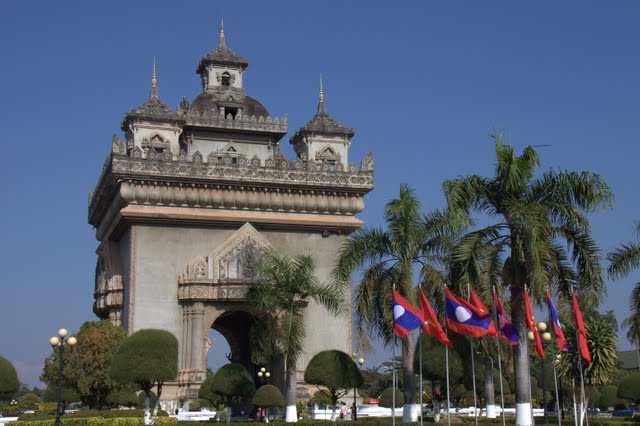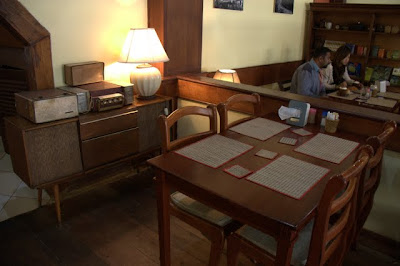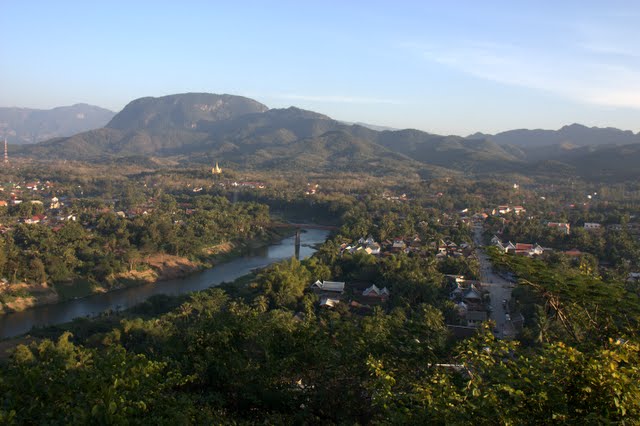Hog Tales – Motorbiking the Bolaven Plateau, Day One: Born to be Wild.
Get your motor running
Head out on the highway
Looking for adventure
In whatever comes our way– Born to Be Wild, Steppenwolf
After moving along with the masses between Laos’ popular cities, we were itching to set off on our own to explore parts of Laos with more Laotians than foreigners. A motorbike road trip around Southern Laos seemed to be just the ticket. Similar, but each unique, trips had been taken by Shanna and Derek at One Year on Earth, Theresa and Jeff at Lives of Wander, and Wes at Johnny Vagabond, inspiring us to get out on the open road. One small problem. Our entire repertoire of motorbike riding consisted of a brief scoot around Lastovo Island on a severely underpowered scooter and a couple of rides around Havelock Island on an automatic scooter. Given our motorbike experience, it makes perfect sense for us to set off on a Honda Wave 100 cc manual motorbike on a four day, three night motorbiking trip on a loop in the Bolaven Plateau, a remote rural area of southern Laos, right? Right. Glad you agree.
The motorbike trip, which, spoiler alert, was one of our best experiences of our whole trip so far, almost didn’t get off the ground. We had reserved a motorbike at our hotel the night before we planned to set off from Pakse. Or, at least, so we thought. When we went to pick up the bikes, they were mysteriously all in need of repair, even though they were sitting out the night before for rent. Well, not sure what that was all about, but whatever, we didn’t want some defective bike anyway. We then tried to find another bike to rent. Contrary to what Lonely Planet/Travelfish/Wikitravel told us, Sabaidy 2 Guesthouse does not rent out bikes (or have maps, for that matter). Okay, we’ll try again. We found a shop that had bikes for rent sitting out front, but when we inquired about, you know, actually renting them, the girl in the shop just shook her head no. Hmmm…is someone trying to tell us something? We then checked in with the shop by the Langham Hotel noodle shop, which seemed to be the most popular place for bikes. The guy working there tried to tell us the bikes he had were too small for two people. Now, I know we’re bigger than the Laotians by a long shot, but I know what these motorbikes can handle: families of six (spotted by Sean, true story); televisions, enough cases of Beer Lao for a small village, bags of rice, you name it. There was talk of giving up and just heading straight to the 4,000 Islands. But then we saw two full-sized Western adults drive by on the same motorbike the guy told us was too small for us. Screw it, we said. Everyone else is doing it!
Soon thereafter we were zooming down the highway, making our way towards Paksong, a small village high up on the Bolaven Plateau. It turns out that Laos is a good place for a beginner to ride. The further we got away from Pakse, the less traffic there was. Other than the occasional truck or bus barreling past with its horn blaring, or some piece of primitive farm equipment loaded to the gills with hay with Laotians perched precariously on top, there aren’t that many vehicles on the road that are bigger than you. It’s a good feeling to be cruising down the road, wind whipping past, and sunshine on your face. After months of noisy, overcrowded buses, the feeling felt the closest to freedom we’d encountered in a long time.
The drive on the first day was short; only 50 kilometers. (That’s 31 miles to you Americans. Avery: Well how far is the border? Maybe we could run! Jack: I don’t know. When I asked the lady at the desk she told me in kilometers!) Paksong is coffee country in Laos, and the further we got away from Pakse and the closer we got to Paksong, it seemed that out front of every wooden house was a pile of coffee beans drying in the sun on a tarp.
Even after a late start, we were in Paksong by lunch time and made our way over to Koffie’s coffee shop. Koffie is a rather quirky Dutchman who married a local Lao woman and now lives with her family in the village surrounded by coffee plantations. Apparently Koffie loved coffee long before he ended up in the coffee heartland of Laos, so it was a perfect match. At Koffie’s coffee shop, you’ll find the only wi-fi in Paksong and coffee that was grown practically in the back yard. Koffee roasts the coffee in small batches in a wok, giving each batch a different flavor. I’m not really a coffee fan, unless it’s spiked with sugar, milk and chocolate and blended into a million calorie Frappachino, but Koffie’s coffee? It could make me reconsider. The flavor was so nuanced and the different notes lingered on your tongue. It reminded me of single-origin cocoa beans I tasted in the bars of Pierre Marcolini I sampled in Brussels.
Sean always regretted missing out on a tour of a Kona coffee plantation on our honeymoon, so we decided to go on Koffie’s coffee tour, which appeared to be offered once or twice a day whenever people wander by. Traipsing past coffee trees, Koffie explained to us the growing, picking, drying, and roasting process. Even better than learning about coffee, for me, was getting a little peek into rural Lao life that we weren’t able to see from the roadside. Up close, we could see laundry strung on lines underneath the simple wooden houses we saw from the road earlier. In the late day sun, women climbed into trees to retrieve low-hanging fruits. We watched kids playing volleyball in a field while their younger brothers and sisters yelled Sabaidee! and giggled every time we walked by. The giggle of the Lao children is infectious – although the adults do not smile much until you draw them out, the children don’t yet have reservations. While Koffie was explaining the benefits of shade-grown coffee to us, we kept hearing giggles from behind the trees where two little girls were playing a paddy-cake game.
For dinner, we headed to the Borlaven Restaurant on the outskirts of town, per Koffie’s recommendation. Shivering from the chilly temperatures in Paksong’s higher elevation, we ordered steamy bowls of Lao noodle soup and through in some laap for good measure. Laap is a Laotian dish made from minced meat, herbs and lime juice. We watched through the screen as the family prepared our order, each member having a role. The youngest daughter was in charge of peeling garlic; guess your family rank determines your job. Upon receiving our order, I recalled what I had previously read about laap: that traditionally it is served raw, but in most tourist restaurants, the chicken will be cooked. Well, this was no tourist restaurant. Despite its aromatic smells, there was no way I was eating raw chicken coming off of two weeks of a stomach bug up north. Good thing the noodle soup was extra tasty.
There wasn’t much of anything going on in Paksong (must not have noticed the brothel down the road) so we headed back to our hotel, Phuthevada Hotel. Sitting high on the hill overlooking the town, and easily the most expensive option in town even though it was only $13 for a double for the rooms in the building in the back, we felt a little pretentious. But the room was nice and clean, and most importantly, there was a television. We specifically got a room with a television in the hope that in some crazy random off chance that we would pick up the Steelers’ first playoff game on our favorite channel, the Asian Sports Network, but as we suspected as we set off into a very rural part of one of the most rural countries in the world, no such luck. Unfortunately, what the hotel also did not have was heat, so we hunkered down to watch the one English speaking channel, a movie channel devoted to showing the random collection of movies ever assembled. First, there’d be an obscure movie, such as the Bill Murray film Broken Flowers that we actually had seen before, or Falling Angels, a rather intriguing movie about three sisters coming of age in the sixties in a dysfunctional family in Canada (the Canadian location never occurring to us until we looked up the movie when we got back to the interwebs). Immediately after the obscure movie, the channel would show a second-rate, made-for-tv movies that probably never saw the light of day elsewhere. Highlights included a horror movie with a severed head that gave me nightmares and a super cheesy Western/Vietnam War movie. Who knew watching movies from bed could be important cultural lessons in of themselves. Apparently the communists believe that the actual placing of a smoking device to one’s lips that corrupts the public, but dangling cigarettes from the character’s hands and rampant swearing are no problem. What really cracked me up was a scene in Falling Angels. The actual smoking of the bowl? Not okay to show. But the lighting of the bowl, the exhaling of the smoke, and the passing of the bowl, all okay. I’m so glad I wasn’t corrupted by the placing of lips to bowl. I could rest easy now, save for severed head nightmares.

One of the girls on the coffee tour handed out pens to the children in the village. As you can see, this girl was quite excited to receive hers. (If you are thinking about heading into the Lao countryside, consider buying some books from the NGO Big Brother Mouse in Luang Prabang to distribute to kids in the villages. I am kicking myself for not doing this).
Next time on Hog Tales: Karma gets its revenge for our nicknaming a couple who took a spill on the scooter in the Andamans “Roadkill.” Stay tuned.
The Frenchies were here.
Vientiane, population 726,000, was, as promised, the sleepiest capital city we’ve ever seen (well, except maybe Ljubjlana). Sure, it’s the biggest metropolis in Laos, but that’s not saying much in a country with six million people. Vientiane has scatterings of influences leftover from French Indochina, including a supposed replica of Paris’ Arc de Triomphe, although the sign on the monument describes it as “a monster of concrete” that gets “less impressive” the closer you get. I’m not sure who wrote the sign at the monument, but I’m guessing it was the French.
Say what you will about the French, though, but one does have to pay homage to the baguettes and pastries they’ve left in their wake. A lingering stomach bug meant I didn’t eat any proper French meals at any of Vientiane’s French restaurants, but Vientiane turned out to be a good place to take it easy and nurse myself back to health. There’s just not a lot to actually do there, for starters, and my daily diet included lots of tummy-friendly Laotian noodle soups, the first real baguettes we’ve had since Paris, and homemade yogurt and bananas drizzled with the sweetest honey from Champasak, Laos, that I had eaten in my life to date. (I say that because the wild honey at Epic Arts Cafe in Kampot, Cambodia, gave the Champasak honey a run for its money several weeks later – and I’m not even a honey fan).
And, okay, maybe a non-tummy friendly pastry or two consumed. Try to contain your shock.

Vientiane teens roaming around town. It wasn't hard to take a picture without cars in it, even on Vientiane's main drag along the river.

The pastry counter at Le Cafe Banneton. Go for the baguettes, pastries, and honey, but when the service sucks, don't say I didn't warn you. After bringing an overcharge to their attention, they actually ended up charging me MORE. When you're in Asia for months and you find pastries this good, though, you let it slide.

The most important thing we did in Vientiane - learn about the effects of unexploded ordnances in Laos. We visited MAG, a non-profit group dedicated to clearing the ordnances in Laos. 30% of the 2 million tons of bombs the United States dropped on Laos during the Vietnam War failed to detonate. To this day, the unexploded ordnances pose safety risks - people die every year - and keep Laotians poor because they are too scared to farm their land. While the United States has sent some money to Laos for clearing efforts (and doesn't donate more in part because of concerns of efficiency of the government), the amount is way short and unexploded ordnances are still a big problem.
If it hasn’t been your day, your week, your month or even your year…
To say I was not a fan of Vang Vieng is only putting it mildly. Vang Vieng is a small town between Luang Prabang and Laos’ capital city, Vientiane, located among limestone mountain karsts and the Nam Song River. Its claim to fame is being a party mecca for young backpackers who come there to go tubing down the beautiful river and allow themselves to be reeled in to shore to drink Beer Lao and Lao-Lao whiskey by the bucketful. Sean had no interest in tubing, so we only stopped overnight to check out the scenery and break up the trip between Luang Prabang and Vientiane. By all accounts, Vang Vieng is touristy, Westernized, and rowdy, and most travelers whose blogs I read seemed to view Vang Vieng as a guilty pleasure after their visits. So I was prepared to see some good-natured debauchery and even the strange phenomenon of cafe after cafe running endless loops of Friends, the Simpsons, and Family Guy.
But I underestimated the scene in Vang Vieng. I know lots of people love it, and I’m sure I sound like the old, thirty-something fuddy-duddy that I am, but to me, Vang Vieng is a giant frat party gone out of control. From dusk onward, the streets are filled with stumbling, obnoxious kids clad only in skimpy bathing suits (in a very conservative country) and with lewd sayings written in marker up and down their bodies. As one group stumbled by, cackling and shouting, a bikini-clad girl filled her companion’s cup to the brim with whiskey. He chugged it down and threw his cup on the street while yelling “F*ck yeah!” like he was in the basement of a college house and not a guest in someone else’s country.
Despite listening to pounding bass late into the night (thank you Travelfish reviewers who called our hotel “quiet;” you apparently are deaf or didn’t come back to the room until 4 a.m.), we decided to take the afternoon bus to Vientiane and first check out an organic farm up the river. If we thought this would get us away from the rowdiness in town we’d be sadly mistaken; the farm has the unfortunate location of being right near the start of the tubing. This means instead of peaceful sounds of birds chirping, the farm gets to hear the sounds of competing music screeching out over the river.
Other than the noise pollution, the farm was lovely. We took a tour led by “Mr. T”, a little Laotian man who is passionate about organic farming and leading by example. He hopes to show other local farmers that organic farming can be profitable and healthy. The farm centers around its mulberry trees, used for mulberry tea, mulberry wine, mulberry tempura and most deliciously, mulberry shakes. The farm also grows organic vegetables and fruits (we saw starfruit and jackfruit trees, for example) and has chickens, pigs, and goats. In addition to sustainable farming, the farm also runs various projects for the community, such as building inexpensive housing out of local materials, paying fair wages to local people, running schools for local kids, and a goat lending program where locals receive goats and repay their debt with baby goats.
Hearing about one man’s efforts to better the local community made me less cranky about our stopover in Vang Vieng (or at least until the tuk-tuk driver insisted on charging us $5 to return to town even though they were already going that way any way to pick up more tubers). Besides eating delicious fresh organic meals by the river, and learning more about organic farming in a third-world Communist country, it gave me a different perspective on the party scene in Vang Vieng that I wish more travelers would consider. There’s nothing wrong with having a good time, but it shouldn’t be at the expense of a community. I’m not even talking about people’s claim that Vang Vieng is a former shell of its former, sleepy self and that its Lao culture had disappeared; that happens to a lot of places where tourism takes over. I’m talking more specifically about the locals who lived by the river long before tubing came to town, who have to listen to the partying day in and day out, who can’t afford or who don’t want to move. I’m talking about the little Lao kids who see the drunk, raunchy foreigners and think all foreigners are that way or that it is an appropriate way to behave. Both the travelers who participate in behavior they wouldn’t necessarily engage in at home and locals who profit from the travelers are all complicit. There’s nothing wrong with letting loose and having a few beers and some fun, but I wish more travelers would think more about the consequences of their actions.
Now that I’m done ranting, if you could please get off my lawn.
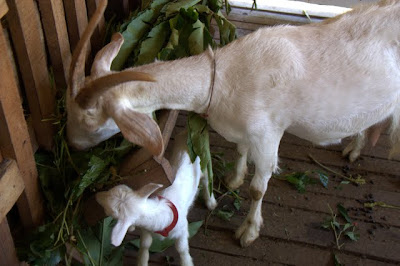
Mr. T greeted the goats with "Bonjour" instead of "Sabaidee." Most of the goats, used for the farm's community lending program and to make goat's cheese, were donated by a Frenchman.

If you don't think about how they are destined to become your bacon, these baby pigs are adorable. We watched this pink guy doggedly worm his way in between his polka-dotted buddies.
Lou-ahng Prah-bang
I’m really bad at foreign pronunciations. Like, REALLY bad. And Sean isn’t much better, which usually leads to horrendous butchering of our upcoming destinations until we can get there and figure out how in the hell to say the names. I even mispronounce easy words. I always pick the wrong way to say it. But wouldn’t you agree that Lou-ahng Prah-bang is so much more fun to say than Lou-ong Prah-bong? I thought so.
Our eight days in Luang Prabang, like much of our time in Laos, were spent chilling and taking in the lovely surroundings. We’d usually muster up the energy to engage in one “activity” per day, if you count eating chocolate chip cookies at our favorite cafe as an activity, which I do.

Rules on the back of our hotel door. Number 5 amused me because it apparently okay to have a one night stand, just as long as no love is involved. Number 6 is very upsetting and foiled our plans.

Sunset over the Mekong viewed from Phou Si Hill. Where you get a great view of the Mekong and the gorgeous greenery around town (see above)...

...shared with hundreds of your new best friends. Yes, you won't be the only one in Luang Prabang, and you probably won't learn much about local culture while your there, but gosh darn it, Luang Prabang is beautiful.

The Luang Prabang night market. We must have walked through it at least once per day but never bought anything. I may or may not have added to my growing scarf collection from one of the fair trade stores in town, however.

A hundred thousand times better than getting up at the crack of dawn to watch the alms giving ceremony is simply monk-spotting around town. We spotted these monks having fun and goofing around during bath time in the river. Every thing about the moment was beautiful - the lighting in the late afternoon sun, their orange robes against the riverside greens, the spontaneity of it all, and the joy of the monks without our intrusion on their fun. (If you go to the alms ceremony, which we did, I know you won't be THAT tourist who sticks his or her camera right in the monks' faces, right? We saw way too many of THOSE tourists treating the monks like zoo animals instead of showing respect for their religious ceremony).

Along Luang Prabang's riverfront. Luang Prabang sits alluringly between the Mekong River and the Mae Kok River.

In a town full of cafes, Saffron was our absolute favorite. Between their free wi-fi, real deal chocolate chip cookies, their organic, fair-trade local coffee, and their huge breakfast combos with bacon and cheese eggel bagels, tropical fruit salad, and cinnamon rolls, we were in heaven.

The French Indochinese architecture around town is what put Luang Prabang on the map as a UNESCO World Heritage Site.

Veggie street buffet. Gotta love a heaping plateful of dinner for just $1.25. Choose your dishes wisely - the ladies running the buffet dump all your choices together to heat them up.

Kouang Si Waterfalls, outside of Luang Prabang. The most gorgeous falls we've seen - since Plitvice National Park, that is.
I know what I’d be making for the game if I was at home…
…but instead I’ll be eating pho in Vietnam. Sad face.
Check out this black and gold recipe from one of my favorite food/travel bloggers Akila and her Steelers-loving husband Patrick at The Road Forks. May I note that they don’t even live in Pittsburgh and their dog wears a Steelers shirt. Steeler Nation is awesome.

